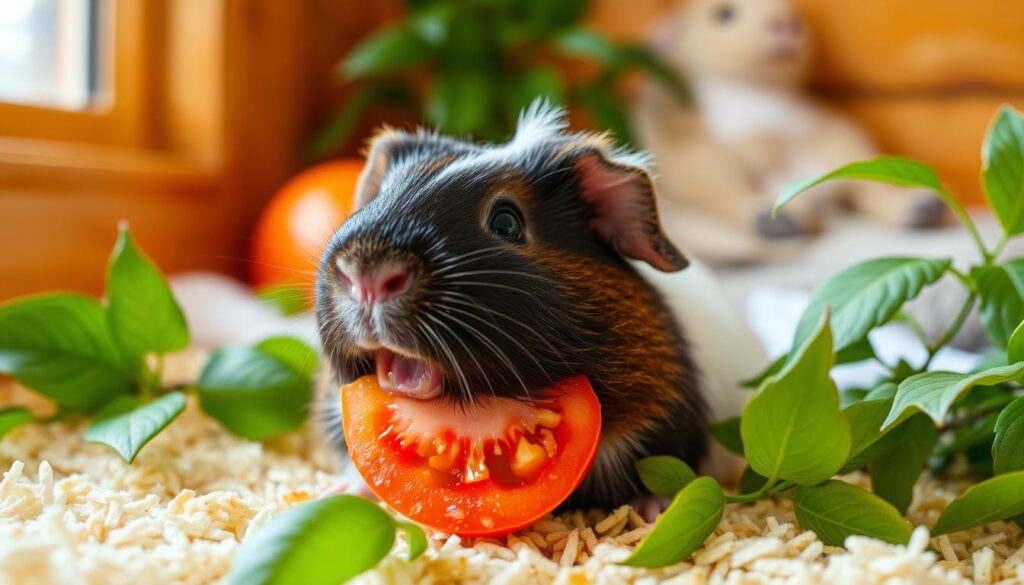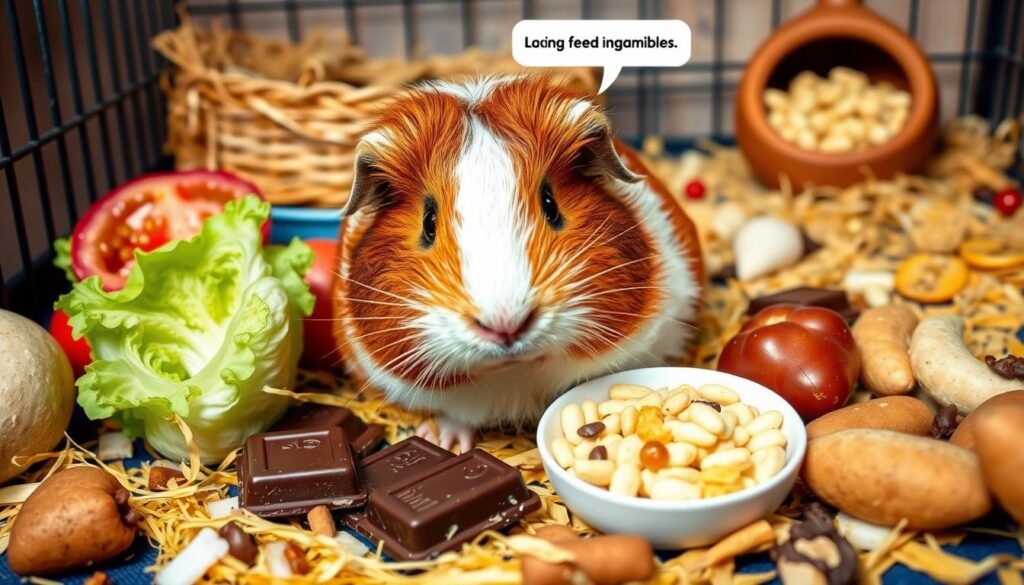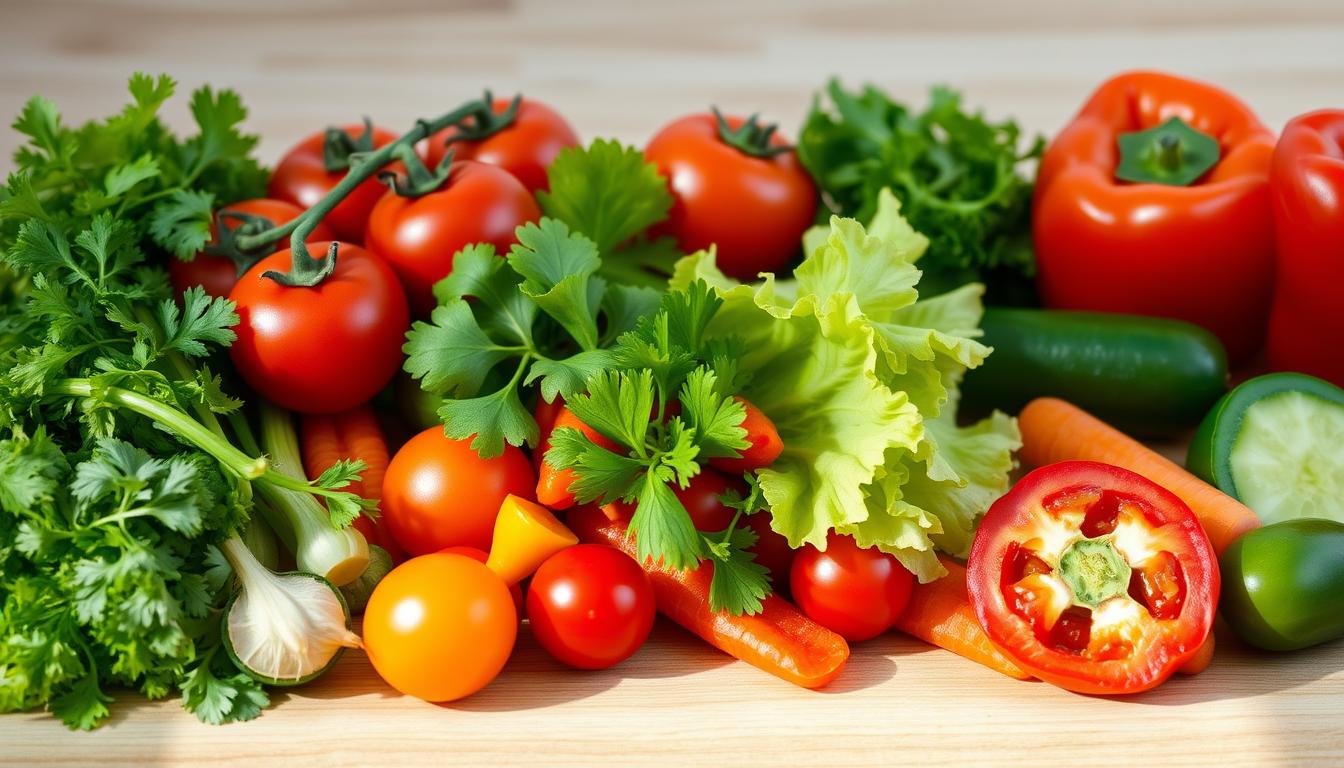As a devoted guinea pig parent, you care deeply about their health and happiness. You want to give them a diet that’s both nourishing and fun. But, you might wonder if tomatoes are safe for them to eat. In this guide, we’ll dive into the details of tomatoes and guinea pigs, helping you make the best choices for their care.
Table of Contents
Understanding Guinea Pig Diet Basics
It’s key to give your guinea pig a balanced diet for their health. Knowing what they need is important for their well-being.
Essential Components of a Guinea Pig Diet
A guinea pig’s diet should have a few main parts:
- Hay (80-90% of the diet): Hay helps with digestion and keeps their teeth healthy. Timothy hay, Orchard grass, or Meadow hay are great options.
- Vegetables (10-15% of the diet): Fresh veggies like bell peppers, cucumber, carrots, and leafy greens are full of vitamins and minerals.
- Pellets (5-10% of the diet): High-quality, vitamin-fortified guinea pig pellets can add to their diet.
Daily Nutritional Requirements
Guinea pigs need certain nutrients every day to stay healthy. They need fresh water and a diet rich in:
- Vitamin C (16-30 mg/kg), as they can’t make it themselves
- A balanced calcium-to-phosphorus ratio for strong bones and teeth
- Enough fiber for a healthy digestive system
The Importance of Balanced Nutrition
Guinea pigs need a balanced diet to thrive. A diet too rich in sugar, fat, or protein can cause obesity and health problems. Offering a variety of hay, veggies, and quality pellets ensures they get all the nutrients they need.
| Nutrient | Recommended Daily Intake |
|---|---|
| Vitamin C | 16-30 mg/kg |
| Calcium | 0.5-1.2% |
| Phosphorus | 0.3-0.6% |
| Fiber | 18-22% |
Knowing what a guinea pig’s diet should include helps keep them healthy. This ensures they get the nutrients they need to live well.
Can Guinea Pigs Have Tomatoes
Many people wonder if guinea pigs can eat tomatoes. The answer is yes, but only in small amounts. Tomatoes are okay as an occasional treat for guinea pigs.
But, not all tomato parts are safe. The fruit is fine, but avoid the stems, leaves, and green tomatoes. These contain tomatine, which can harm guinea pigs.
So, you can give your guinea pig a little bit of ripe tomato now and then. But, tomatoes should not be a big part of their diet. They have too much sugar and acid.
| Safe Tomato Parts for Guinea Pigs | Unsafe Tomato Parts for Guinea Pigs |
|---|---|
| Ripe, red tomatoes | Unripe, green tomatoes |
| – | Tomato stems and leaves |
Start with small amounts of tomatoes and watch how your guinea pig reacts. Some might not like the acidity or sugar. Always introduce new foods slowly and in small amounts.
For a happy guinea pig, a balanced diet is key. This includes hay, fresh veggies, and the occasional treat. Knowing which tomato parts are safe helps you make better choices for your pet.
Nutritional Benefits of Tomatoes for Guinea Pigs
Tomatoes are great for guinea pigs, offering many important nutrients. They are especially good because they have lots of vitamin C.
Vitamin C Content and Its Importance
Guinea pigs can’t make vitamin C on their own. This vitamin is key for a strong immune system and healthy bones. It also helps prevent scurvy, a serious disease. Tomatoes have about 30-50 mg of vitamin C per serving, which is what guinea pigs need every day.
Other Beneficial Nutrients
- Potassium: Tomatoes are full of potassium, which helps keep fluids balanced and supports muscles and nerves in guinea pigs.
- Antioxidants: Tomatoes have antioxidants like lycopene. These help protect cells and keep guinea pigs healthy.
Hydration Benefits
Tomatoes also help guinea pigs stay hydrated. They have a lot of water, which is great for keeping them cool and healthy, especially when it’s hot.
Adding tomatoes to your guinea pig’s diet is a tasty way to help them stay healthy. Just remember to feed them in moderation and introduce new foods slowly. This way, your guinea pigs can enjoy tomatoes safely and without any problems.
Safe Feeding Guidelines for Tomatoes
Feeding guinea pigs tomatoes can be safe and fun. But, it’s key to follow some simple rules to keep your pet healthy.
Start by giving tomatoes as an occasional treat, about 1-2 times a week. A small slice or a single cherry tomato is enough. This prevents them from eating too much sugar.
- Always wash the tomatoes well to get rid of pesticides or residues.
- Make sure to remove the seeds, as they can be a choking risk.
- Cut the tomatoes in half to lessen the acidity on your guinea pig’s lips.
When adding new foods, do it slowly to avoid upset stomachs. Start with a little and watch how your guinea pig reacts before giving more.
“Introducing new foods gradually is crucial to ensuring your guinea pig’s digestive health and preventing any adverse reactions.”
By sticking to these guidelines, you can add the nutritional benefits of tomatoes to your guinea pig’s diet. This makes for a tasty and healthy guinea pig treat.

Potential Risks and Considerations
Tomatoes can be good for your guinea pig’s diet, but there are risks. Some guinea pigs might not be able to digest tomatoes well. This could cause stomach problems or allergic reactions.
Signs of Tomato Intolerance
If your guinea pig shows these signs after eating tomatoes, stop giving them to them:
- Diarrhea or loose stools
- Vomiting or nausea
- Lethargy or lack of energy
- Skin irritation or rashes
When to Avoid Feeding Tomatoes
Some guinea pigs should not eat tomatoes, even if they’ve had them before. This includes:
- Pregnant or nursing guinea pigs
- Guinea pigs with kidney or liver problems
- Young guinea pigs under 6 months old
Before adding tomatoes or new foods, talk to your vet. They can help decide what’s best for your guinea pig.
It’s important to know about guinea pig food safety and tomato risks for guinea pigs. This way, you can make sure your guinea pig stays healthy. By watching for problems and following the right feeding rules, you can add tomatoes to their diet safely.
Proper Preparation and Serving Size
Feeding tomatoes to your guinea pig needs careful preparation and portion control. First, make sure to wash the tomatoes well to get rid of any harmful chemicals. Then, cut them into small pieces, removing seeds and stems to avoid choking hazards.
The right serving size for guinea pigs is a small slice or one cherry tomato per meal. It’s important to never give your guinea pig cooked or processed tomatoes because they can be bad for them. Always give fresh, raw tomatoes to keep your pet healthy.
When introducing new foods like tomatoes, do it slowly and watch closely. Look out for any signs of intolerance or digestive upset. If you’re worried about preparing vegetables for guinea pigs or the right guinea pig portion sizes, talk to your vet.
“Proper preparation and portion control are essential when feeding tomatoes to your guinea pig.”
By following these tips, you can add tomatoes to your guinea pig’s diet safely. This way, they get the nutrients they need without facing any dangers.
Incorporating Tomatoes into a Varied Diet
When you’re making a meal plan for your guinea pig, adding tomatoes is important. Mix tomatoes with other safe veggies to give your pet a balanced diet. This way, your guinea pig gets all the nutrients they need.
Combining with Other Safe Vegetables
Try pairing tomatoes with veggies like bell peppers, cucumbers, and leafy greens. This makes meals look good and adds nutrients. Bell peppers are full of vitamin C, and cucumbers help keep your pet hydrated.
Weekly Meal Planning Tips
Make a weekly meal plan that changes up the veggies, including tomatoes. This keeps meals exciting and ensures your pet gets all the vitamins and minerals they need. Try new veggie mixes to keep your guinea pig’s meals interesting.
A good guinea pig diet has 80% fresh hay, 1/8 cup of vitamin C pellets, and 1/2 to 1 cup of fresh veggies. By planning and mixing veggies, your guinea pig gets a diet full of nutrients. This supports their health and happiness.
Common Mistakes to Avoid
Feeding your guinea pig right is key to their health. Tomatoes can be good, but feeding them wrong can be bad. It’s important to know how to feed them safely.
Don’t overfeed tomatoes or any food. Guinea pigs need a mix of foods to stay healthy. Too much of one thing can upset their stomachs.
- Avoid feeding unripe tomatoes, as well as the leaves and stems, as these can be toxic to guinea pigs.
- Never substitute tomatoes for the essential components of a guinea pig’s diet, such as hay or pellets. These staple foods should always remain the foundation of their meals.
- Gradual introduction of new foods, including tomatoes, is crucial. Sudden diet changes can cause stress and digestive problems for your furry friend.
By avoiding these mistakes, you can make sure your guinea pig gets the good from tomatoes. A balanced diet is what keeps them happy and healthy.

Alternative Vegetables and Fruits
Tomatoes are great for guinea pigs, but they should not be the only food. Other safe veggies include bell peppers, carrots, and leafy greens like romaine lettuce, kale, and broccoli. These foods are full of fiber, vitamins, and minerals that help your guinea pig stay healthy.
For fruit treats, you can give your guinea pig apple slices (without seeds), berries, and melon. But remember, fruits have a lot of sugar. Eating too much can cause diabetes and obesity. Always check new foods first and talk to your vet to make sure you’re giving the best safe fruits for guinea pigs and guinea pig produce.
It’s important to keep your guinea pig’s diet varied and rich in nutrients. By offering a range of safe foods, you help your pet get all the vitamins, minerals, and fiber they need to be happy and healthy.

